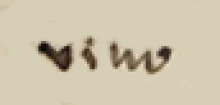vino (CST3)
This is a painting of the simplex glyph for the term vino (wine), which was introduced by the Europeans into this hemisphere. It was stored and served from a goat skin bag, as probably shown here, a practice that dates from Roman times and still exists in Spain today. This bag shows a durable seam and a tie at the neck, since the bags were often hung up.
Stephanie Wood
The purchase of wine was probably for use in the church. Octli was, for a long time, the beverage of choice for Nahuas in this period. The tlahuanqui (drunk) who appears in the Florentine Codex does not have a wine skin, but he has a ceramic pitcher with a liquid. For more on the Codex Sierra, see Kevin Terraciano’s study (2021).
Stephanie Wood
1550–1564
Jeff Haskett-Wood
bebidas, botas, piel, cuero, vinos, alcohol

vino, wine (a loan from Spanish taken into Nahuatl), https://nahuatl.wired-humanities.org/content/vino
vino
Stephanie Wood
Códice Sierra-Texupan, plate 3, page dated 1551. Origin: Santa Catalina Texupan, Mixteca Alta, State of Oaxaca. Kevin Terraciano has published an outstanding study of this manuscript (Codex Sierra, 2021), and in his book he refers to alphabetic and “pictorial” writing, not hieroglyphic writing. We are still counting some of the imagery from this source as hieroglyphic writing, but we are also including examples of “iconography” where the images verge on European style illustrations or scenes showing activities. We have this iconography category so that such images can be fruitfully compared with hieroglyphs. Hieroglyphic writing was evolving as a result of the influence of European illustrations and even alphabetic writing. https://bidilaf.buap.mx/objeto.xql?id=48281&busqueda=Texupan&action=search
The Biblioteca Digital Lafragua of the Biblioteca Histórica José María Lafragua in Puebla, Mexico, publishes this Códice Sierra-Texupan, 1550–1564 (62pp., 30.7 x 21.8 cm.), referring to it as being in the “Public Domain.” This image is published here under a Creative Commons license, asking that you cite the Biblioteca Digital Lafragua and this Visual Lexicon of Aztec Hieroglyphs.



